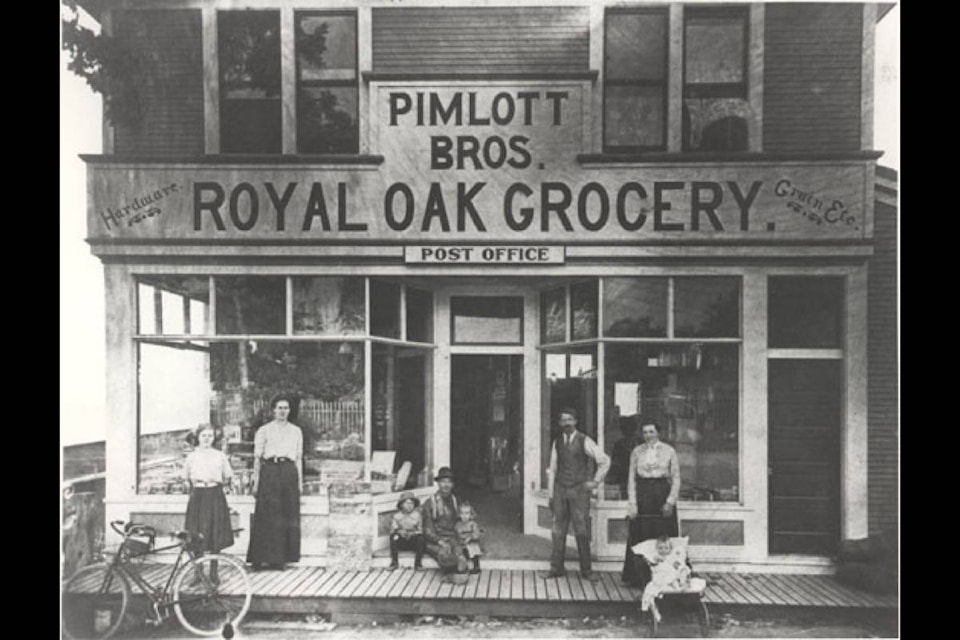By T.W. Paterson
“Across the throat was a deep, jagged gash which had completely severed the arteries and jugular vein.”—Colonist.
Last week’s tale of a skeleton found at Royal Oak was almost repeated some 40 years later, but with a major difference—this time the mystery was solved.
Again, the discovery was solely by chance, by a man taking a shortcut through the bush about “half a mile above Young’s post office on the Saanich road”. Mr. Pimlott,” the Colonist reported, “was on his way to church and, on turning into the bush, noticed a light fedora hat. He naturally became curious as to how the article came [to be] there, and on turning round to investigate saw the form of a man lying not more than two feet away from him.”
Pimlott’s first thought was to notify the authorities and he set out with this in mind. But, upon returning to the road, he encountered chief jailer R.J. John, who happened to be driving by. John insisted that Pimlott show him the body and accompanied him to the scene. John’s examination of several effects found at the site convinced him that the body was that of David Ferguson who’d vanished three months before. He then notified the provincial police.
That afternoon, Constables Campbell and Cox, Peter Ferguson, brother of the missing man, and the undertaker reached the site. They found the body as Pimlott had left it, “lying on its face, both arms underneath; but, collar and necktie were lying alongside. On turning the body over they discovered a pearl-handled knife was clasped tightly in the right hand and covered with flesh and blood. Across the throat was a deep, jagged gash which had completely severed the arteries and jugular vein.”
Despite the condition of the body the face was readily identifiable to the brother and others who’d known David Ferguson.
Ferguson’s disappearance had created something of a sensation in Victoria, he having last been seen on the mornng of Dec. 10, 1903, “sober and in apparent good health”. After having breakfast in the Dominion Hotel, where he’d been staying since his arrival from the Interior two months befor, Ferguson wasn’t seen again until the church-going Pimlott chose to cut into the bush in Saanich. A reward of $1000 had been posted for information leading to his whereabouts but, after months passed without a clue as to his fate, had been withdrawn.
On March 14, an inquest was held by Coroner Dr. E.C. Hart and a six-man jury. After being sworn and shown the body, the jury listened as Peter Ferguson identified the remains as those of his brother David. He stated that he’d last seen him about December 11 or 12. Although drinking at the time, David had appeared to be in good health and gave no indication of “having any trouble”. Peter hadn’t realized that his brother was missing until December 21.
James H. Pimlott then explained how he’d been on his way to church that afternoon, had had occasion to step off the roadway and follow a wood-cutter’st rail. Fifty yards into the bush, his curiosity had been piqued by the finding of a hat, followed by that of the body, which he’d then reported to Gaoler John.
After identifying himself as a good friend of the deceased, Arthur Cook testified that he’d last seen Ferguson while walking in Beacon Hill Park. Ferguson had acted naturally and had appeared to be in good health.
Thomas Stevens, manager of the Dominion Hotel, declared that he’d also identified the body as that of David Ferguson, who’d been a guest of the hotel until his disappearance. Ferguson, Stevens said, had been a heavy drinker until his last two days in the hotel, when he’d appeared to be sober but ill. Ferguson had been very reserved throughout his stay, except when drinking, and shy with strangers.
Constable Cox concluded the inquest by stating how he’d examined the body and how he’d tentatively identified it by personal papers and effects found at the scene. After brief deliberation the jury ruled that David Ferguson had taken his own life while in a fit of despondency.
And that, such as it was, was that. At least it likely brought what we’ve come to term closure for Ferguson’s family.
twpaterson.com
